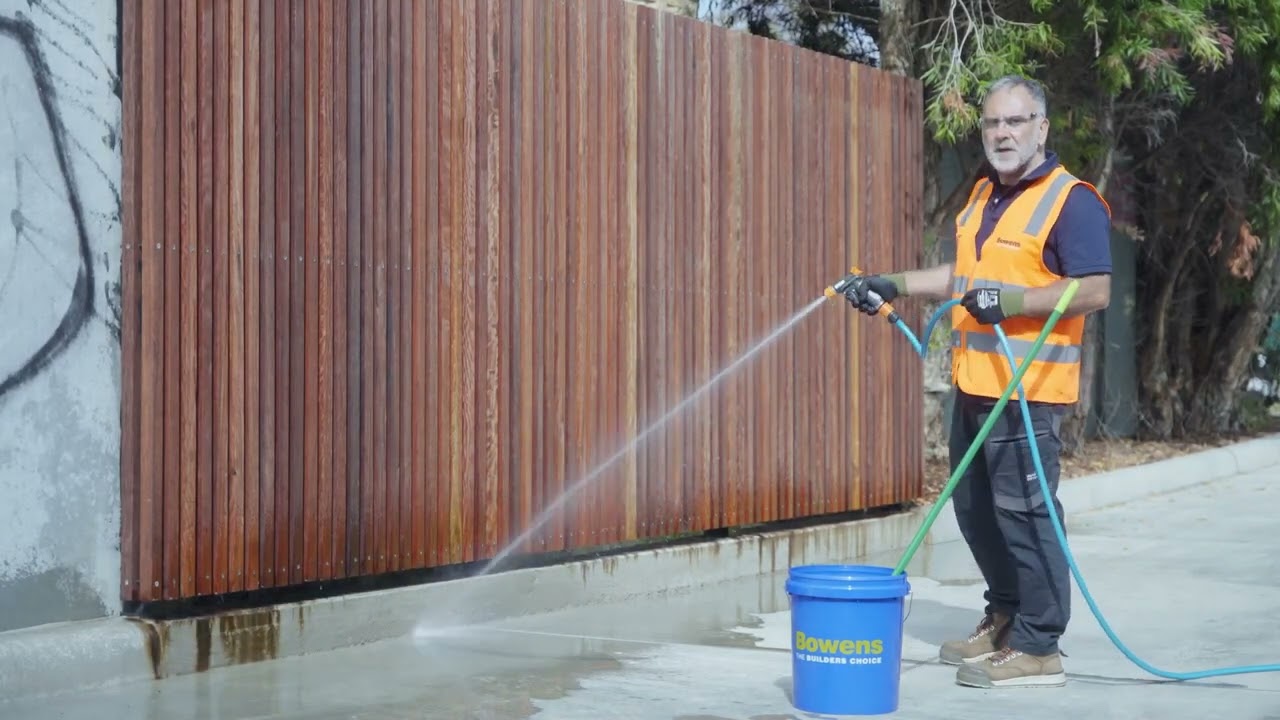Merbau wood is a popular choice for outdoor fencing in Melbourne due to its durability, rich brown color, and natural resistance to pests. However, despite its many advantages, Merbau wood has one significant drawback: tannin bleeding. Tannins are naturally occurring compounds found in many woods, and Merbau contains high levels of tannins. When exposed to moisture, such as during Melbourne’s rainy season, these tannins can leach out, causing unsightly stains on the fence and surrounding areas like pavements, driveways, and walls.
Tannin bleeding is a common issue with Merbau fences, especially in climates with heavy rainfall like Melbourne. Fortunately, there are several preventive measures and treatments that can significantly reduce or eliminate tannin bleeding, keeping your Merbau fence looking beautiful and well-maintained. In this article, we’ll explore what tannin bleeding is, why it happens, and provide detailed guidance on how to prevent and manage tannin bleeding in Merbau fencing.
What Is Tannin Bleeding?

Tannins are organic compounds found in a variety of plants, including wood. They are responsible for the deep, rich hues of many types of timber, including Merbau, which has a beautiful reddish-brown color. However, when exposed to water or moisture, tannins in the wood can leach out, resulting in a process known as tannin bleeding.
This can manifest as dark brown or reddish stains running down the surface of the wood or even onto nearby surfaces like concrete, brick, or stone. Tannin bleeding is more likely to occur in new Merbau fences or freshly installed timber that has not yet been adequately treated. This process is exacerbated during rainy seasons, such as Melbourne’s frequent wet months, when the wood is exposed to prolonged moisture.
Why Does Tannin Bleeding Occur in Merbau?
Merbau wood contains higher levels of tannins compared to many other timber types. The wood’s pores allow water to penetrate the surface, dissolving the tannins and causing them to flow out of the wood. When it rains, the water triggers this reaction, leading to tannin bleeding. This can be an especially frustrating issue for homeowners who have recently invested in a new fence, as it detracts from the aesthetic appeal of the wood and may stain surrounding areas like patios and paths.
While tannin bleeding is a natural occurrence, it can be controlled and prevented with the right preparation and maintenance techniques.
Steps to Prevent Tannin Bleeding in Merbau Fencing
To minimize or eliminate tannin bleeding in your Merbau fence, you must take preventive steps before, during, and after installation. These steps involve proper timber preparation, sealing, and ongoing maintenance to protect the wood from moisture and to control tannin release.
1. Pre-Treatment of Merbau Timber
The first step in preventing tannin bleeding begins before the fence is even installed. Pre-treating the Merbau timber to reduce the amount of tannins present on the surface can help minimize bleeding once the fence is exposed to rain.
Soaking the Timber
One of the most effective pre-treatment methods is to soak the Merbau timber in water for a few days before installation. This soaking process helps draw out some of the tannins from the wood, significantly reducing the amount that could leach out later.
- Step 1: Submerge the Merbau timber in water (a large trough or container works best) for at least 24 to 48 hours. Make sure all parts of the wood are fully submerged.
- Step 2: Change the water periodically as it becomes stained with tannins. The darker the water, the more tannins are being released.
- Step 3: After soaking, allow the timber to dry completely before proceeding with installation. This can take several days, depending on the thickness of the wood and environmental conditions.
Pressure Washing
If soaking is not feasible, you can pressure wash the timber to remove surface tannins. Use a low-pressure setting to avoid damaging the wood fibers. This method can be effective for reducing tannins, but it is generally less thorough than soaking.
2. Applying a Quality Sealer

Once the Merbau timber is treated and dried, the next critical step is to apply a high-quality sealer. Sealers form a protective barrier on the surface of the wood, preventing water from penetrating the timber and causing tannins to leach out. Sealing Merbau fencing is essential, particularly in Melbourne’s rainy climate.
Choosing the Right Sealer
There are various sealers available, and choosing the right one is key to preventing tannin bleeding. Look for sealers that are specifically designed for high-tannin woods like Merbau. Penetrating oil-based sealers or water-based acrylic sealers are commonly used for outdoor fencing.
- Oil-based Sealers: These penetrate deeper into the wood and offer long-lasting protection. They enhance the natural beauty of the wood and are effective in reducing tannin leaching.
- Water-based Sealers: Water-based sealers form a protective film on the surface of the wood, providing excellent moisture resistance. These sealers dry faster and are environmentally friendly.
Sealing Process
- Step 1: Ensure the Merbau fence is completely dry and clean before applying the sealer. Any remaining moisture in the wood can prevent the sealer from adhering properly.
- Step 2: Apply the sealer using a brush, roller, or spray. Make sure to cover all surfaces evenly, including edges and ends, where tannin bleeding is more likely to occur.
- Step 3: Apply at least two coats of sealer for optimal protection. Allow the first coat to dry fully before applying the second coat. Depending on the product, drying time may range from a few hours to 24 hours.
- Step 4: Reapply the sealer periodically (every 1-2 years, depending on weather conditions) to maintain the fence’s protection against moisture.
3. Proper Drainage and Design Considerations
The installation of Merbau fencing should be done with proper drainage and ventilation in mind. Poor drainage can exacerbate moisture retention in the wood, leading to increased tannin bleeding during Melbourne’s rainy season.
Ensure Good Ventilation
Good airflow around the fence can help prevent excessive moisture buildup, allowing the wood to dry more quickly after rain. When installing the fence, ensure there is adequate space between the panels or boards for air circulation.
Prevent Water Pooling
Ensure that water does not pool around the base of the fence. Standing water can lead to more severe tannin bleeding and accelerate the wood’s deterioration. Installing gravel or drainage channels around the perimeter of the fence can help direct water away from the base.
4. Cleaning and Maintenance

Even with pre-treatment and sealing, some tannin bleeding may still occur, especially during the first few months after installation. Regular cleaning and maintenance of the fence can help manage and reduce the appearance of tannin stains.
Cleaning Tannin Stains
If tannin bleeding occurs, it’s essential to clean the stains as soon as possible to prevent permanent discoloration of surrounding surfaces like concrete or brick.
- Step 1: Use a tannin remover or a mild solution of oxalic acid and water to clean the stains. These products are effective at breaking down tannins and removing discoloration.
- Step 2: Apply the cleaner with a soft brush or sponge, working it into the stained areas.
- Step 3: Rinse the area thoroughly with water after cleaning to remove any residue.
Ongoing Maintenance
To maintain the appearance and longevity of your Merbau fence, inspect it regularly for signs of wear or damage. Reapply a sealer every 12 to 24 months, depending on exposure to the elements. Regular cleaning with mild detergent and water can also help keep the fence looking its best.
Alternative Wood Choices and Coatings

If tannin bleeding is a major concern, you may also consider alternative woods or synthetic materials for your fencing. Woods with lower tannin content, such as treated pine or hardwood alternatives, can offer similar durability without the risk of tannin leaching.
Additionally, synthetic or composite fencing materials are becoming increasingly popular for their durability, low maintenance, and resistance to issues like tannin bleeding, mold, and warping. While they may have a higher initial cost, they offer long-term benefits with fewer maintenance concerns.
Conclusion
Tannin bleeding in Merbau fencing during Melbourne’s rainy season is a common yet manageable issue. By pre-treating the timber, applying a high-quality sealer, ensuring proper drainage, and maintaining the fence regularly, you can significantly reduce or even prevent tannin bleeding. Proper care will not only protect your investment but also enhance the natural beauty of the Merbau wood, allowing you to enjoy your fence for years to come. With the right techniques and products, you can keep your Merbau fence looking pristine, even through the heaviest of Melbourne’s rains.





